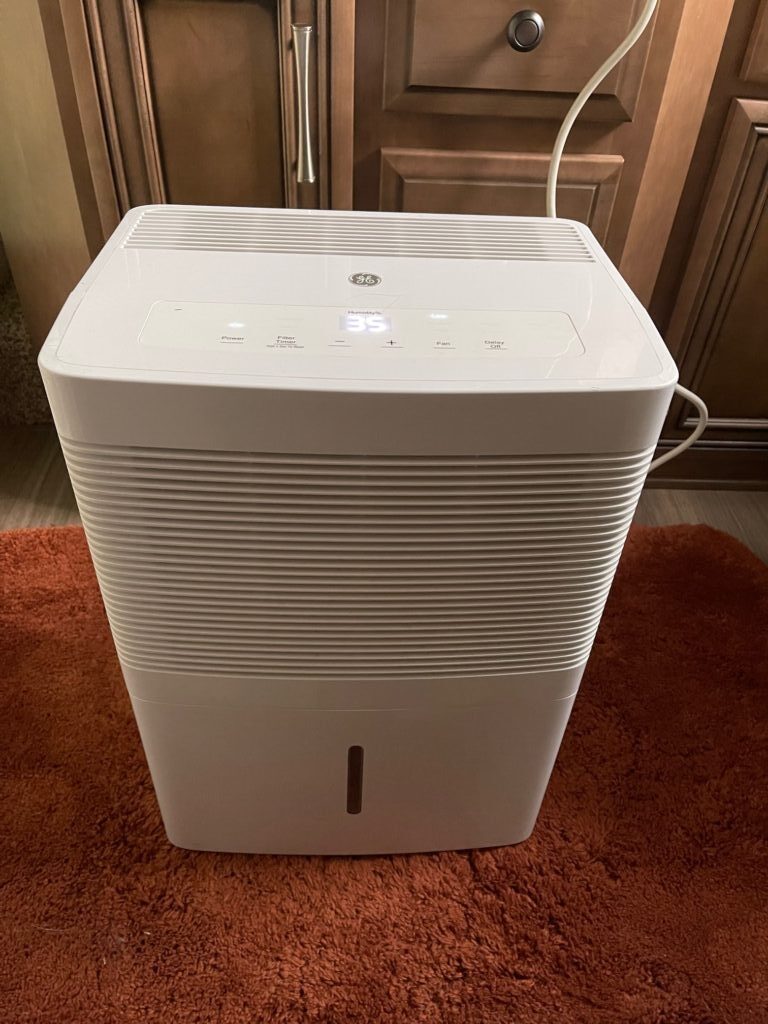
Pros and Cons of Traveling with an RV Dehumidifier
Regardless of where you live or store your RV, at some point, you’ll need to manage the humidity in your RV. Managing moisture inside your RV is critical to your rig’s longevity. And, your enjoyment of this valuable asset.
Obviously, humidity is higher in some regions of the country than others. But regardless of where you’re located, it is a ubiquitous problem for all RVers. After all, we all exhale. Through a process called “insensible water loss” the average person loses about 23 fluid ounces of water through their skin and breath daily.
If there are two people and two dogs inside an RV for 24 hours, there will be approximately 60 fluid ounces of extra water in the air just from them. That is in addition to any humidity that may result from condensation on metal and glass surfaces. Or mosture that enters the RV through the doors and windows.
If you’re cooped up in your RV for a week with little outside ventilation, the amount of airborne moisture circulating throughout your coach could be several gallons of water. And that is a problem! It will gather on hard surfaces, penetrate soft surfaces, get into the insulation, and under the wall treatments. Water in the air will cause poorly ventilated areas to mold. None of these conditions are desirable. It’s not good for humans, pets, or the rig.
Areas with high humidity
If you are RVing in an area with high humidity, this problem is only compounded by the relative humidity in the ambient air. We’re originally from the Pacific NW where the weather is notoriously wet. But we had no idea what real humidity was until we traveled to Florida at the end of October 2019.
The temperature an unbearable 95 degrees. And humidity was so high we were drenched just walking across the parking lot. We literally could not catch our breath because of the oppressive humidity. Somehow we needed to transfer our RV gear from the older RV to the one we had just purchased. But this simple physical activity was nearly impossible due to the combination of heat and humidity.
The air and surfaces inside the coach were damp the whole time we were in that climate. Once we got back on the West Coast, the coach began to dry out. But that was only because the humidity outside was low.
Now we’re back in the Pacific NW. It’s too cold and wet to open the windows. The humidity from insensible water loss has been building up in the rig for days. Now we need to take active measures to manage the humidity in the RV. Fortunately, we travel with an electric RV dehumidifier. This helps combat the accumulation of moisture.
What problems are caused by humidity?
How important can this be you may ask? If you only take your rig out on the weekends and it’s in storage the rest of the time, is managing humidity in your RV really that important? Yes!
One of our friends was very careful to close up his rig and cover it with an RV tarp when it was not in use. In the spring when he got ready to de-winterize it, he noticed some damage in the headliner even though there was no way that the roof was leaking.
On further inspection, he discovered that the entire surface under the headliner had been damaged by dry rot and all that damage was the result of humidity. He was forced to sell that rig and in his next RV, he was diligent to manage the build-up of moisture.
How do you control humidity in an RV?
There are many ways to control humidity. Even if your rig is in storage, you will still need to manage the humidity inside of the rig.
Dry air inside an RV is ideal. Wet air inside an RV is a problem waiting to manifest itself in mold, decay, and destruction. The most efficient method to reduce water in the air is to use an RV dehumidifier.
What is the best RV dehumidifier?
There are many different types of RV dehumidifiers, from dry pellets that are used inside a special housing, called Dri-Z-Air or DampRid which are manufactured and sold for the RV industry, to dozens of electric dehumidifiers. Other options include the Air-Dryr and the Eva Dry.
We have tried the dry pellets but they only remove limited amounts of water. The pellets need to be replaced frequently, and the pellet’s absorption of moisture creates unpleasant toxic wastewater.
We have also tried three different electronic dehumidifiers. The first one was huge, heavy, and noisy. It could extract quarts of water daily, but it was always in the way because it was so large.
The second dehumidifier was actually two separate countertop-style appliances.
Those were very small, quiet, and completely useless in terms of the volume of air from which water needed to be extracted. These small countertop units might have been fine in a closet or small bathroom but in our 33-foot Class A motorhome, they were no match for the build-up of moisture.
The third RV dehumidifier (pictured at the top of this article) is actually very efficient. It is relatively compact and compared to the first one, it is also relatively quiet. It will extract quarts of water in an eight-hour period and it can be easily repositioned from one end of the RV to the other.
Even with this device operating all day, we are barely able to keep up with the accumulation of water in the air when the outside conditions are wet. We’re in Oregon, in the winter, and unfortunately, it’s always wet. Whenever it stops raining, we can open a window to ventilate the rig, but it’s the Oregon Coast, and it’s always raining.
Make sure you also have a quality hygrometer like this one to monitor the humidity levels in your RV, whether you’re on the road or when your RV is sitting in storage for the winter. For more tips, check out this article from Do It Yourself RV on How To Reduce Condensation In Your RV.

Dehumidification cannot be over emphasized, as this article states. Our RV used to smell like mold, no matter how clean the tanks were, or how many Damp Rids had been hung in the RV. We tried those rechargeable devices, and they didn’t do the job for us either.
Then we read about dehumidifiers. It is unbelievable how much water the inside of an RV collects. We bought a 50 pint dehumidifier, and in a matter of days its tank was full, and the moldy smell began to dissipate. Now the RV smells just fine, and we run the dehumidifier periodically. The dehumidifier is one of the best investments we’ve made; it restored the livability of the interior of the RV.
Great article, hope more folks see this information.
Mrs Dent. Can you please indicate which model dehumidifier you have, I see it’s a GE.
Dehumidifier model # of the one you like please
It is NOT Always raining in Oregon. But keekptelling people that is is and maybe less of those Califoricators will move up here. Oregon used to be a great state but not anymore.
So which one worked the best. The large GE model at the beginning of the article? Model #?
This is an extremely valuable article that all RVers should heed. It’s one limitation is that it should have placed the blame for humidity problems squarely on the manufacturers. Providing for humidity control should be built-in and nearly automatic.
You say to monitor the humidity inside the rig. WHAT level should it be at if you’re managing the moisture effectively?
Also, what IS the dehumidifier pictured at the top of the article? It looks huge.
After reading the article, I’m still not sure what you recommend.
The statement “That is in addition to any humidity that may result from condensation on metal and glass surfaces…” is incorrect. Condensation is a sign that you have too much humidity, but it is not a “cause” of it. Condensation is the result of humid air contacting cooler surfaces. In fact, this works just like your dehumidifier does, condensing water vapor into liquid water by exposing it to a cold surface (basically an air conditioner).
Of course, the amount of humidity “removed” by the surfaces within your RV are not enough to combat the humidity problem, and can cause water damage themselves. Just wanted to correct the quoted statement.
The model at the top is a GE and you stated that it worked the best, however you failed to tell us what model it was. Can you please provide that info so that we can get one too? Greatly appreciated. Great article and very useful. 😉
The one at the top of the article LOOKS quite large. Please provide the model number so we can look at it more closely.
There is no link to the one you use. Please provide more info. Thanks.
I bought 2 Lenovo Dehumidifiers from Amazon at about $39 each. I have a 32′ Outlook Class C. They work great and maintain the RH at right about 50%. I used to use Damp Rid, but that is now history. The Lenovo units are small, quiet, and actually quite good at getting the humidity out here in TX.
LONOVE Dehumidifier at AMAZON.
$39.99 Just and FYI.
Great reviews.
We full time in Florida and just run the ac in summer. It seems to do the trick we’ve never had a dehumidifier.
Seams to be a more one time use? Uses the beads. Not practical for a RV in highHumidity area. I use this one, works great 👍🏼
https://smile.amazon.com/gp/product/B073V9MG3Y/ref=ppx_yo_dt_b_search_asin_title?ie=UTF8&psc=1
Hi. Does anyone have advice over whether dehumidifier water can be drained into the sink if it runs straight out of the trailer and not into the grey water tank? In my general research I’m seeing that bacteria in the water from the air should not go into the tank, but it’s not clear to me whether it would also be a problem for the pipes and hoses.
You dump your dirty kitchen sink water so yeah, dump humidifier water down the sink. Whether it goes into a holding tank or not doesn’t matter. There’s bacteria everywhere.